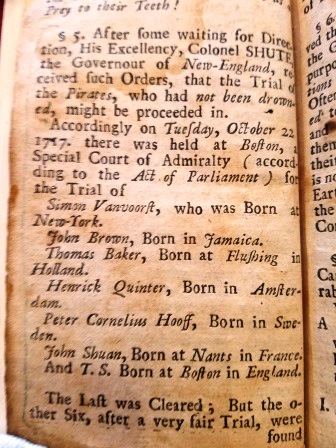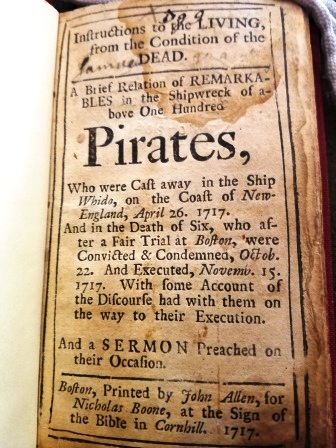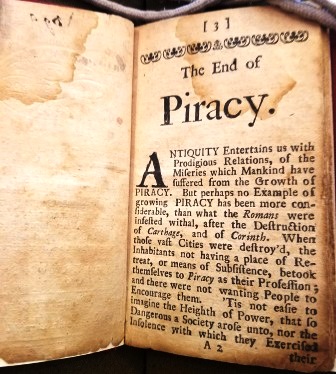By Rakashi Chand, Reader Services

Today marks the 300th anniversary of the execution of the Whydah pirates in Boston, Massachusetts, marched from their Boston jail to the gallows and hanged for their crimes of piracy.
No less a person than Puritan minister Cotton Mather recorded the day of the execution in his diary:
“15. G. D. There is good this Day to be done, on a very solemn Occasion. Six Pirates were this Day executed. I took a long and sad walk with them, from the Prison, to the Place of Execution. I successively bestowed the best Instructions I could, upon each of them. Arriving to the Tree of Death, I pray’d with them, and with the vast Assembly of Spectators, as pertinently and as profitably as I could.”
*****
Not much is known about young Samuel Bellamy, also known as Black Bellamy, the captain of the Whydah. Bellamy and his crew captured the three hundred ton merchant slaver Whydah as it left Jamaica on route to London in late February or early March of 1717. The ship originally had 18 guns but the crew mounted an additional ten, making it a formidable sight for any vessel to which it gave chase. According to one of the pirates, John Brown, they had about 20,000 pounds in gold and silver aboard the Whydah from “a-pyrating.” Bellamy brought his fleet to the outer shores of Cape Cod, legend says, to see a beautiful young lady by the name of Maria Hallett, whom he fell in love with on the dunes of Eastham the year before. If Maria truly did exist, we do not have a historical record; but it is more likely that the pirates came north to trade their plunder (desirable illicit goods) with eager merchants in Newport, Connecticut, New York, and Boston.
The Whydah sank off the shore of Cape Cod the night of April 26th, 1717. When the storm rose up that caught the Whydah off the coast of the Cape, the ship was driven onto the shoals and it soon became apparent the Whydah would not survive. Thirty foot waves destroyed the ship and drowned almost all of the pirates and their prisoners. The next morning inhabitants of the nearby towns discovered on the beach the gruesome sight – countless gnarled bodies washed ashore by the tides along with wreckage from the ship – which would haunt them for years. At least 102 bodies washed up on shore.
This was the fate of Captain Bellamy and his pirate crew, except for seven survivors who were arrested and sent to Boston for trial. One of the seven, Thomas Davis, was found innocent and released, then disappears from record. The other six men were found guilty of piracy through trial: John Brown, Simon Van Vorst, Hendrick Quintor, Thomas Baker, Peter Hoof and John Shuan.

*****
Cotton Mather went often to visit, study, instruct and ultimately try to provide salvation for the pirates in their Boston jail. It seems the good minister was thoroughly intrigued by these ‘sinners’, and to our great benefit, for without his writings about the fates of the Whydah pirates we would have little record.
After the execution, Mather wrote Instructions to the living, from the condition of the dead : A brief relation of remarkables in the shipwreck of above one hundred pirates, who were cast away in the ship Whido, on the coast of New-England, April 26. 1717. And in the death of six, who after a fair trial at Boston, were convicted & condemned, Octob. 22. And executed, Novemb. 15. 1717. With some account of the discourse had with them on the way to their execution. And a sermon preached on their occasion. [Boston, Printed by John Allen, for Nicholas Boone, at the sign of the Bible in Cornhill. 1717]


Thanks to this pamphlet – available here in the collection of the Massachusetts Historical Society – we have the conversations and words of the pirates themselves. Mather published his Instructions to the living, from the condition of the dead… a mere month after the execution, perhaps to appease the great curiosity the pirates had caused, while also using the event as an opportunity to teach his flock. Mather again revisited the subject in his sermon “Warnings to Them that Make Haste to be Rich” on 8 December 1717.
So why did Cotton Mather go to meet with these pirates and why did he put so much thought into their state? He was, for all intents and purposes, interviewing dead men tried, and as Mather clearly stated, “after a fair trial,” convicted and sentenced to death. So here he writes “What may be offere’d, is, A Recollection of Several Passages, which occurred in discourse with the prisoners, while they walked from the prison to the Place of Execution.”

Oh my, can you imagine walking to your execution, your last moments on this earth, while Cotton Mather asks you questions? Perhaps Mather saw this as an opportunity for himself; after all there was nothing more wretched in all the world than a pirate and if he, the great moral ballast of the colonies, could save their souls, well, there would certainly be Puritan brownie points to be earned!
Mather ends his account with “Behold, Reader, the End of Piracy!”
*****
Most Bostonians today would be surprised to learn that a few hundred years ago Boston was known as a “Port Where Pirates Hang.” Even more surprising is how we got that reputation because, indeed, we hanged pirates, and yes, they were an actual problem! So the next time you watch Pirates of the Caribbean or celebrate “Talk like a Pirate Day,” think no further than the streets of Boston!
For more on Cotton Mather materials here at the MHS, start with this online collection guide for the Cotton Mather papers view our collection guide, then consider Visiting the Library!

